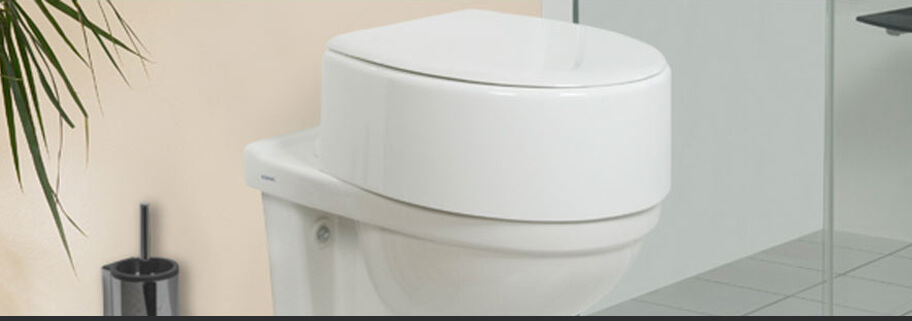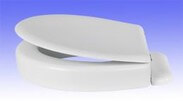Toilet Seat Boosters
The Perfect Sitting and Standing Aids!
- WC seat with lid raises the toilet seat by 2”, 3.1”, 4” 4.75” or 6.3” (5, 8, 10, 12 or 16 cm)
- Suitable for all common toilet bowls
- Skin-friendly material
- More hygienic, thanks to the closed underside
- Our toilet seat boosters / standing aids are also available in a version suitable for very heavy users (up to 55 st. (350 kg)).
Our toilet seats, which are supplied as standing aids or as anti-decubitus seats, consist of an easy to clean solid material and can be folded up. Result: no hollows or edges, where grime can build up. These are available individually for WCs, as well as in combination with the VAmat. - Stable mounting of the toilet seat booster using stainless steel screws
- A variety of colours – white – Bahama beige – Manhattan (grey), at no extra charge
- Delivery from the Hanau warehouse
- Toilet seat boosters for very heavy users up to 47.25 st. (300 kg) available on request
Child Attachments
Our child attachments can be delivered in association with the VAmat WC douche and for standard seats for single mounting from the Spahn Reha GmbH warehouse. These attachments are also suitable for older, underweight users.
Advantages of the Spahn Reha Toilet Seat Boosters
While there are countless solutions for day to day sitting and lying down, the demands made on a WC seat in rehabilitation are more diverse. While a toilet seat booster, as a rule, presents itself as unproblematic, in the prevention of decubitus, a solution for the toileting area is more problematic. The user at risk of decubitus is, as a rule, a wheelchair user. It should be added that mobility is potentially limited and there are problems of balance due to lack of feeling. Depending on their use, WC seats should feature the following characteristics:
Firm mounting
Wheelchair users, as a rule, change seats by moving sideways i.e. by supporting and relocating (“throwing their bodies”). Extreme lateral forces come about, which can cause the WC seat to slip, break, or otherwise become damaged if the WC seat is not adequately affixed to the toilet bowl. On no account are toilet seats suitable, where suction cups, clamps or retaining straps have been used to attach these (Risk of accident!).
Standard toilet seats and anti-decubitus toilet seats by SPAHN REHA have a special stainless steel fastening element and can be optimally fastened to the toilet bowl in various positions using stainless steel screws.
Body management
In order to convey a feeling of safety to the toilet user when sitting, the body should not be permitted to tilt while seated, i.e. the body requires lateral support. This necessitates a separate non-positive stabilisation of the seat using special stabilisers integrated into the seat in non-positive conjunction with the fastening element, as well as a firm mounting (as described above). Padded or merely foam-covered seats do not fulfil this criterion. The same applies to seats whose base is made from wood or plastic. SPAHN REHA toilet seats fulfil the criteria.
Surface
Fundamentally, the surface of a toilet seat must not be too smooth. Nor should it be too deeply textured. If the surface is too smooth, the user will stick to it; the decubitus prophylaxis is no longer effective. If the surface is too deeply textured (rough), sitting will feel uncomfortable, if the user has feeling. The texture should prevent sticking. The rule is: as little texture as possible, as much texture as necessary! SPAHN REHA has optimised the texture, based on 18 years of experience. Creases are prevented from occurring.
Hygiene
Hygiene is particularly important for an anti-decubitus toilet seat. After all, this seat will also be used by those who already have open wounds. For this reason, the following criteria for optimum hygiene should be fulfilled:
- Smallest surface possible for the seat, because smaller areas gather less grime.
- Closed porous material, to avoid the absorption of moisture.
- Easy accessibility to all parts of the seat can be folded up for optimum cleaning, removable without tools. Material suitable for disinfection.
- Before flushing, the lid should always be closed (bacterial contamination).
Pressure distribution
Because of the different anatomies of individual users, absolute decubitus prophylaxis is only possible in the rarest of cases. However, experience shows that individuals find their ideal sitting position very quickly. Essentially, the larger the seat area, the smaller the contact pressure. The body burden can be influenced by contouring and the use of pressure absorbing material. Foams, as a rule, do not absorb pressure, since, under a load, the material deforms to one side and the user is sitting hard on the core (the base plate). SPAHN REHA also has long-term experience in respect of pressure distribution.






